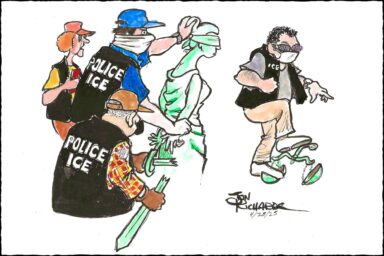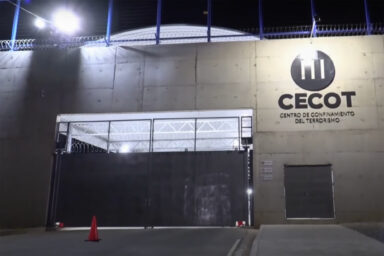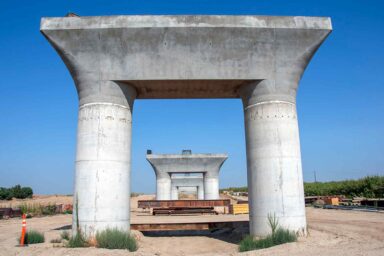A look at the existing border walls and borderlands between the US and Mexico, and the unique landscape they have created.
President Donald Trump will probably never build one foot of his wall. Still, today there are 650 miles of border wall already dividing the US and Mexico. It’s almost one-third of the entire border. It divides cities, families, private property, and even impacts wildlife and habitats.
We journey to the border in this week’s WhoWhatWhy podcast, as Jeff Schechtman is joined by Ronald Rael, associate professor in the department of architecture at UC Berkeley.
According to Rael, the borderlands are like a third nation, combining some of the best of language, food, and culture of the US and Mexico. More profoundly, the existing wall is just as much a place of connectivity as it is of division.
Rael explains that the current wall is actually a form of architecture. As such it defines space and in so doing defines places. It keeps people apart, but he details how it also encourages the coming together of people in unique ways.
Since we are putting them up, the current walls are structures that are always built on the US side of the border. The result are vast borderlands between the wall and Mexico. With no viable uses, this creates an otherworldliness in the areas that are sequestered behind it.
Rael points out that over the next 25 years, it will cost $49 billion just to maintain the existing structures. He speculates on what else could be built along the border with that money: things like massive solar fields or water treatment plants that would have a far greater and more positive impact on both the US and Mexico.
Click HERE to Download Mp3
Full Text Transcript:
As a service to our readers, we provide transcripts with our podcasts. We try to ensure that these transcripts do not include errors. However, due to time constraints, we are not always able to proofread them as closely as we would like. Should you spot any errors, we’d be grateful if you would notify us.
| Jeff Schechtman: | Thanks for joining us here at Radio WhoWhatWhy. I am Jeff Schechtman. While the Trump border wall probably will never happen, no matter who pays for it, at best it could be a cause to think about its consequences, its possible reality, and what it might mean for the US, for Mexico, and for the people that live close to both sides of the border. In fact right now, as a result of previous efforts, 650 miles of wall is already there. In various forms, it covers one third of the entire border. It gives us a very powerful idea of what more wall might do in a region that is almost a third country along the border. |
| To build a picture of this, I’m joined by my guest, Ronald Rael. He’s an associate professor and chair of the Masters of Architecture Committee in the Department of Architecture at UC Berkeley. He’s the author of the book Border Wall as Architecture, and it is my pleasure to welcome Professor Ronald Rael to Radio WhoWhatWhy. Ronald, thanks so much for joining us. | |
| Ronald Rael: | Thank you very much for having me. |
| Jeff Schechtman: | It’s great to have you here. One of the things that you talk about is that borders are both places of division and places of connectivity. Talk about that idea, first of all. |
| Ronald Rael: | Well, historically the US-Mexico border is simply just a frontier, and it’s a frontier where many cultures are coming together. And still to this day it’s a place that is an exchange for language, for food, for culture, and I think that a wall simply can’t define the division between here or there, necessarily. |
| Jeff Schechtman: | And when you think about that wall, talk about what you see not only in terms of the political consequences, which so much has been talked about, written about, but the social and cultural consequences that could come from something like that. |
| Ronald Rael: | There are even consequences beyond the social and cultural. But the wall in its current manifestation, and there are about 650 miles of wall that are already built along the US-Mexico border, that’s about one third of the entire border that defines our southern boundary. It has, currently, a wall or fence in place. So this divides cities, it divides private property, public lands, and it divides families and communities. And this is a fundamental problem. |
| And it extends beyond that, really. It also divides landscapes, natural landscapes and habitats. So scientists have begun to recognize that there is a lack of genetic diversity among certain animal species because they are no longer able to migrate to their natural habitats in search of food or water. | |
| Jeff Schechtman: | When we look at the current border and we look at those places where there is a wall or a fence that’s there now and those places where there’s not, talk about some of the fundamental differences we see. |
| Ronald Rael: | The borderlands are a very diverse and rich landscape. There are sand dunes, there are marshes, rivers, deserts, cities. So we see that the border wall takes on different forms as it traverses those landscapes. Sometimes in response to those landscapes, but very often they do not respond to those landscapes quite enough. Where some of the planners of the border wall in its current manifestation were building walls in deserts, they never accounted for rains and in some cases a rainfall, which would typically wash across the border, now suddenly encountered a dam which was the border wall and would build up against the wall and in fact on several occasions has knocked down the wall itself. In other cases, the water turned perpendicular to the wall and ran into cities and flooded those cities. So the wall takes on many different shapes and forms as does the context. |
| In each case, it’s not really responding to those contexts because there is… the problems associated with the wall that causes people, for example, to be driven to further extremes in the desert, often causing dehydration and death, for example, so there’s a number of problems that arise from constructing a wall along our southern boundary. | |
| Jeff Schechtman: | One of the impacts that you talk about is that essentially the borderlands are almost a third nation there. |
| Ronald Rael: | Yes. This is not a result of the wall, necessarily, but again this is a landscape where people are coming together. I mentioned language and cuisine and culture, there has traditionally been a kind of borderlands culture where people speak both Spanish and English, the food is a hybrid, and so it’s not necessarily, again, the United States and Mexico, there’s a gradient of culture that exists across this landscape. As is the case in many landscapes throughout the world, we see that in Europe, we see Italian and French and Spanish being mixed in very interesting ways in the borderlands and this is the case here as well. |
| Jeff Schechtman: | To what extent do you think, and some of this is clearly speculation, but do you think that some of this cultural difference, some of this diversity might be different and even more diverse today if even the existing wall were not there? |
| Ronald Rael: | I’m not sure I know the answer to that question, but I think those landscapes are already diverse landscapes. There are many different cultures living along the border, Native Americans, Mexicans, Mexican-Americans, and Americans of their various cultural ancestries. These are already diverse landscapes not only in the human population but in animal and plant populations as well as the kinds of ecosystems are diverse. So this is an extremely diverse landscape, but I think that definitely putting a wall in place has the tendency to call for homogenization. Homogenization in natural ecosystems is never a healthy ecosystem. |
| Jeff Schechtman: | One of the things that you talk about in Border Wall as Architecture is the architecture of walls themselves and how this plays out against the backdrop of what we’ve been talking about. Give us a little sense of that, Ronald. |
| Ronald Rael: | It’s my opinion that the wall is a form of architecture, and in that, that it defines spaces. Now it was constructed without any regard for space, necessarily, but what it has done – and this is contrary to the intention of the wall which is likely to keep people apart and keep people away – it has catalyzed the coming together of people. And I think that’s a really interesting phenomena for the construction of the wall and I’ll give you a couple of examples. |
| There have been places along the border that people have played volleyball to come together to celebrate their binational identities. There have been binational horse races, binational yoga classes, where people on both sides of the wall are participating in a single event. Even just a couple of days ago, between the cities of Douglas, Arizona and Agua Prieta, Arizona… sorry, Sonora, there was a binational theater performance. And coincidentally, I speculated about that kind of performance taking place along the border wall and it actually happened where audiences sat perpendicular to the wall on both sides and the stage was constructed on both sides, watching performances from both sides. | |
| So the wall has served, again, as a vehicle, as a form of architecture to bring people together. And I think this is a really interesting reaction to the wall as a kind of cultural and public activism in opposition to the wall. | |
| Jeff Schechtman: | And as the talk continues about a longer wall, more wall along this 2,000 mile border, are there ways that you could envision where the reality of a wall meets what you’re talking about in terms of the ways that wall might be enriching at the same time? |
| Ronald Rael: | Well, I’m not an advocate for the construction of more walls. I don’t think it’s a good idea. I think that the wall, in its current form, is very damaging. It’s not only damaging to lives, not only comes at a high cost in taxpayer dollars, but it damages our cultural landscapes. I’m not sure that the construction of new walls can do anything to improve our cultural landscape. |
| I am an advocate for borderland investment, because these landscapes are some of our fastest growing regions in both the United States and Mexico and they are also some of our poorest. What I describe in the book are ways to think, or re-think, the kinds of budgets that are spent along the border and, for example, the current wall, in its current form, will cost $49 billion to complete and maintain over the next 25 years. This has nothing to do with Trump. This is the wall that has already been put in place by the Secure Fence Act of 2006 under the Bush administration. | |
| So if we can imagine or envision what else $49 billion could buy along the US-Mexico border, we might imagine new kinds of public and social infrastructures that would improve those landscapes, that would improve the lives of people along the border and make the cities safer and more secure. | |
| Jeff Schechtman: | Can you imagine more cities springing up along the border in some of these borderland areas? |
| Ronald Rael: | I can imagine that, certainly. Populations are always growing in these regions. Again, I mentioned they’re some of the fastest growing regions in the United States. If we look back a hundred years ago or so, many of these towns were very small and have grown together and in some cases grown side-by-side, so there are several sister cities that have grown along the border. Often is the case that much of the metropolitan areas that grow along the border in Mexico push up against that wall in areas that there are walls and really create a kind of dense form of urbanism on the Mexican side of the wall. |
| In some cases, and I talk about this in the book, there’s a scenario where houses are built up right against the wall and use that wall almost like a fourth wall of a house. I do a series of drawings that explore that concept, because the Army Corps of Engineers planned the wall to divide many landscapes and in many cases private property. So I make a speculation about what it would mean if the wall cut through a house and what rooms would it cut through, what would it mean for a wall to divide a bedroom, or a living room, or a bathroom? And what are the construction techniques that are used on each side of that wall? Masonry and cement block and adobe one side and balloon frame construction on the other side. And what are the sizes associated with it? | |
| In many ways that project is meant to speculate on the economy of the wall, the culture of the wall, and what it means to divide these landscapes. | |
| Jeff Schechtman: | What economic impact is it having? Talk a little bit about that. |
| Ronald Rael: | As I mentioned, the construction of the border wall is incredibly expensive. I think it’s having an economic impact in many ways. One of the ways that I think of off hand is that it has… the border wall between the United States and Mexico is always constructed in the United States because it’s an American construction project with the exception of one case where about three miles of border wall was accidentally constructed in Mexico and it cost several million dollars to remove it and move it back into the United States. All of the border wall is constructed in the United States and because much of the political border is along a river, which is constantly meandering, the border wall has to be constructed quite a ways inland into the United States, up to three miles. So it’s not on the political border, exactly, it’s several miles in. And behind that wall is agricultural lands, wildlife areas, Native American lands, private property, farms, agricultural landscapes, golf courses. |
| That land behind the wall suddenly becomes fallow. It becomes inaccessible. And it becomes, in some ways, conceptually ceded or a no-man’s land that is not part of, necessarily, of our economy. So in the case of the golf course, once the golf course of the University of Texas at Brownsville was placed behind the wall, it had to close down, because no one was able to access it any longer and it was no longer profit generating. And this is happening all along the border where we find agricultural lands and other landscapes sequestered behind the wall. | |
| Jeff Schechtman: | Of course there’s certainly every reason to think that if this wall were to grow, if some of these attempts and some of this talk about a longer wall were to ever happen, that it would create more land like that that was inaccessible and essentially lying fallow. |
| Ronald Rael: | Right. Exactly. That would certainly be the case, absolutely. I think that, again, I’m not calling for any new construction of wall, but I’m speculating in the book ways to engage the materiality of the wall, let’s say the material of the wall. As an architect, as a designer, we can be in… or I should say I could be in opposition to the wall, which I am, and I could raise a picket sign and say “down with the wall, no more wall,” and that would be it. |
| But employing the tools of my profession, I am speculating and thinking about the existing context, and in some cases I think there’s opportunities for the transformation of that material. And I say that because I think there’s a way to think about the wall as an armature for new types of infrastructure that would ultimately dismantle the wall’s meaning. It would take away its power in many ways and introduce new kinds of infrastructures into that landscape. | |
| And to be more specific, I think that there is a tremendous opportunity for solar farms constructed in the borderlands. These are the landscapes with the most potential for photovoltaic energy production. So could we convert that material, which is millions of tons of steel, into the armature for photovoltaic plants? And if we compare budgets, we find that… I did a budget comparison in the book that the 87 miles of wall that was constructed between Douglas and Nogales could have been instead a photovoltaic farm for almost the same price. These are the kind of realities that we’re thinking about along the border. What else might we construct for the kind of budgets that are proposed in the borderlands? And how could that benefit both nations? | |
| Jeff Schechtman: | Beyond the solar farm, what are some of the other infrastructure ideas that you talk about in the book? |
| Ronald Rael: | Another infrastructure I talk about is a wastewater treatment plant. In California, we have the New River which flows into what is essentially the bread basket of the United States. This is the most polluted river in the United States, and it begins in the United States, it flows into Mexico, and when it returns and enters the United States, it’s incredibly polluted with pesticides, chemicals, bacteria, and at levels that exceed any kind of allowable form of waterways that we would allow to enter into the United States. |
| But there’s a great irony here which is there is a wall constructed along the point where that river flows into the United States, except that at the moment where the river flows in, the wall ends and the river flows in freely. So it’s interesting to think about what we deem as dangerous and what we attempt to secure behind the wall and what we allow to pass through. So we allow this incredibly toxic river to enter the United States, but I think that, again, an alternative investment in taxpayer money could be a wastewater treatment plant that treats the affluent before it enters into the United States, or as it enters into the United States and brings clean water into the US rather than a toxic river. | |
| Jeff Schechtman: | Ronald Rael, his book is Border Wall as Architecture, a manifesto for the US-Mexico Boundary. Ronald, I thank you so much for spending time with us here on Radio WhoWhatWhy. |
| Ronald Rael: | Thank you very much, I appreciate it. |
| Jeff Schechtman: | Thank you. And thank you for listening and for joining us here on Radio WhoWhatWhy. I hope you join us next week for another Radio
WhoWhatWhy podcast. I’m Jeff Schechtman. If you like this podcast, please feel free to share and help others find it by rating and reviewing it on iTunes. You can also support this podcast and all the work we do by going to whowhatwhy.org/donate. |
Related front page panorama photo credit: Adapted by WhoWhatWhy from border wall Rio Grande (U.S. Customs and Border Protection / Flickr).





